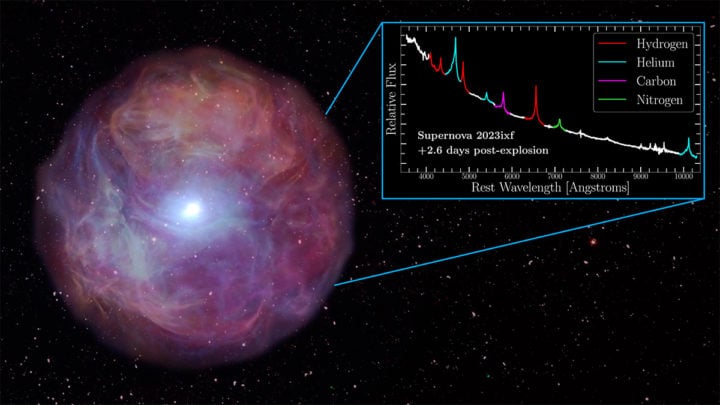According to an international team of scientists, new images of a supernova and its remnant 168,000 light years from Earth have revealed clues about how exploding stars develop over time.

Located in the Milky Way’s neighbouring galaxy, the Large Magellanic Cloud, SN 1987A has been a target of intense observations at every single wavelength from gamma ray to radio since its discovery in February 1987.
The team, led by a researcher from Cardiff University’s School of Physics and Astronomy, says the well-studied supernova SN 1987A images are even better than anything previously observed by NASA’s Hubble and Spitzer space telescopes.
Captured by JWST’s Near-Infrared Camera (NIRCam) instrument on 1 September 2022, the images show previously unseen crescent-like structures in the supernova remnant. These crescents are thought to be part of the outer layers of gas from the supernova explosion.
Dr Mikako Matsuura, a Reader at Cardiff University’s School of Physics and Astronomy who is leading the analysis of the new images, said: “SN 1987A is the closest supernova explosion to Earth detected for the last 400 years. Over that time, it has been observed by almost all major ground-based telescopes in the southern hemisphere and through different generations of space telescopes as well.
“For JWST to reveal previously unknown features such as these crescent shapes in the outflow of the supernova was a big surprise and speaks to the telescope’s abilities to present well-studied structures in new and exciting ways.”
Harnessing the telescope’s unparalleled sensitivity and spatial resolution, the images also show a central structure similar to a keyhole packed with clumpy gas and dust ejected by the supernova explosion nearly 40 years ago.
Dr Matsuura added: “Spitzer observed SN 1987A in infrared for its entire lifespan and gave us an important understanding of how the light from the supernova remnant changes over time. But it was never able to achieve the level of clarity and detail which JWST has delivered with these new images.
Located in the Milky Way’s neighbouring galaxy, the Large Magellanic Cloud, SN 1987A has been a target of intense observations at every single wavelength from gamma ray to radio since its discovery in February 1987.
Like Spitzer, JWST will continue to observe the supernova using its Near-Infrared Spectrograph (NIRSpec) and Mid-Infrared Instrument (MIRI), offering astronomers the ability to capture new, high-fidelity infrared data over time.
JWST will also continue to collaborate with Hubble, Chandra and other observatories to provide new insights into the past and future of this legendary supernova.
Dr Roger Wesson, a research associate at Cardiff University’s School of Physics and Astronomy who is part of the international team working on the analysis, said: “Despite the study of SN 1987A for nearly 40 years now, many mysteries still remain.
“The level of detail revealed by JWST is simply astounding,” said Professor Haley Gomez Deputy Head of Cardiff University’s School of Physics and Astronomy who is also part of the international team.
Source: Cardiff University

